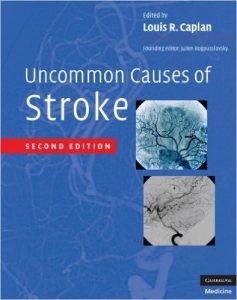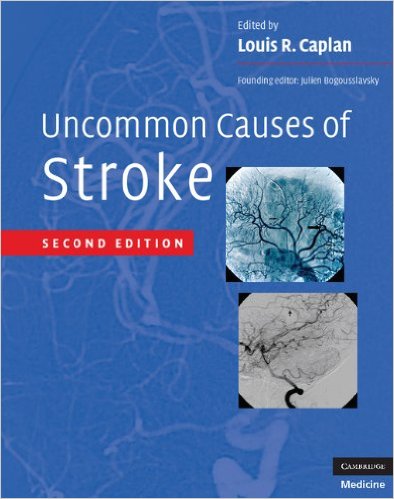 Editor: Louis R. Caplan, MD
Editor: Louis R. Caplan, MD
Publisher: Cambridge University Press – 560 pages
Book Review by: Nano Khilnani
A quick check on www.Amazon.com on “stroke” showed nearly 16,100 available books. With “causes of stroke” we found nearly 10,500, and with the phrase “known causes of stroke” there were 161. So one thing is for sure: stroke (which has been termed simply by some as “a heart attack in the brain”) is a subject on which much has been researched, discovered, and written about because many people fall victim to it.
Yet I’m sure there is still much more to be unearthed, and that knowledge needs to be disseminated, so people can have longer and healthier lives. Living longer means adding years to your life, but living healthier means adding life to your years: enjoying it, not just existing.
The editor and writers of content for this book are doing their part in saving lives and helping people living longer and healthier by sharing their knowledge and insight on this killer disease.
How big a killer is stroke? According to a 14-year-long (1999-2013) study by the Centers for Disease Control (CDC) stroke kills almost 130,000 people a year in the United States, or one every four minutes! Those killed by strokes represent about 16 percent of the 795,000 who get strokes. That person dying of stroke is one of every 20 deaths from various causes. Stroke is the fifth largest killer in the U.S. and about 87 percent of all strokes are ischemic, which is when blood flow to the brain is blocked.
Data from this study also show that the risk of having a first stroke is nearly twice for blacks as it is for whites, and they are more likely to die following a stroke than whites. The risk for Hispanics is somewhere in between blacks and whites. Not only blacks but American Indians and Alaskan Natives are more likely to die following a stroke than whites.
The topmost three risk factors for stroke are: high blood pressure, high cholesterol, and smoking.
With this background information, let us look inside this book Uncommon Causes of Stroke. Basically, the titles of its nine Parts give us clues on what types of conditions and disorders are related to the incidence of stroke, without necessarily pointing to actual causes of this disease. By reading the chapters, you can discover the detailed circumstances that lead to stroke.
- Part I. Infectious and Inflammatory Conditions
- Part II. Hereditary and Genetic Conditions and Malformations
- Part III. Vascular Conditions of the Eyes, Ears, and Brain
- Part IV. Disorders Involving Abnormal Coagulation
- Part V. Systemic Disorders that also involve the Cerebrovascular System
- Noninflammatory Disorders of the Arterial Wall
- Venous Occlusive Conditions
- Vasopastic Conditions and Other Miscellaneous Vasculopathies
- Other Miscellaneous Conditions
One hundred and eleven people including the editor Dr. Louis R. Caplan, from the United States and 16 other countries – Australia, Belgium, Brazil, Canada, Ecuador, France, Germany, India, Israel, Japan, Portugal, South Africa, South Korea, Spain, Switzerland, and Turkey – wrote the 71 chapters of this book. Dr. Caplan wrote or coauthored 13 of those chapters. The chapters are organized around nine Parts we have listed above to give you an overview of what you will find in this large and extensive volume.
Many of the authors are neurologists, and some are neurosurgeons, but there are those whose practice and / or teaching specialties include: cardiovascular medicine, hematology, obstetrics and gynecology, ophthalmology, pediatrics, radiology, rehabilitation, and stroke research.
Many strokes result from atherosclerosis in arteries in the cranium or neck, brain embolism from the heart, or penetrating artery disease. There are many books that cover these and other similar common causes of stroke.
This book provides coverage with detailed, up-to-date information on less common or uncommon causes of stroke, including their nature, diagnostic methods, and treatment options. We name below two types with corresponding examples of these stroke-causing conditions, diseases, disorders, and syndromes:
- Infections and inflammatory conditions: angiitis in various forms, Behcet disease, Burger’s disease, Chagas’ disease, cysticercosis, fungal infections, HIV, Kawasaki disease, Lyme disease, neurosarcoidosis, neurosyphilis, Takayasu disease, temporal arteritis, tuberculosis, varicella zoster and other virus-related cerebral vasculopathy
- Hereditary and genetic conditions and malformations: aneurysms, arteriovenous malformations of the brain, cerebral autosomal dominant arteriopathy with subcortical infarcts and leukoencephalopathy (CADASH), cerebral cavernous manifestations and developmental venous anomalies, cerebrovascular manifestations of neurofibromatosis, Ehlers-Danlos syndrome, Fabry’s disease, Marfan’s syndrome, Menkes disease, MELAS and other mitochondrial disorders, progeria, pseudoxanthoma elasticum, Sturg-Weber syndrome, telangiectasia, Von Hippel-Lindau disease, and Wyburn-Mason syndrome.
This is an excellent resource and a keepsake in the hospital or professional library of any neurologist, neuroradiologist, neurosurgeon, vascular surgeon, angiologist, as well as stroke physician, pediatrician, and internist.
Editor:
Louis R. Caplan, MD is Senior Neurologist at the Beth Israel Deaconess Medical Center and Professor of Neurology at Harvard Medical School in Boston, Massachusetts.







